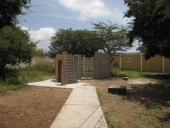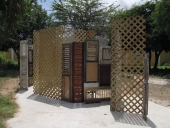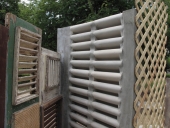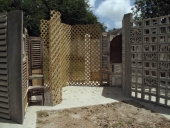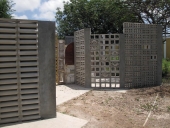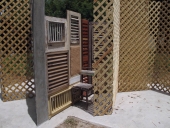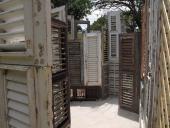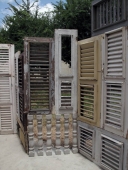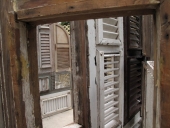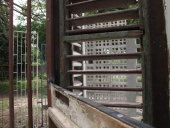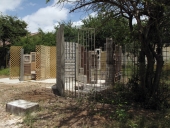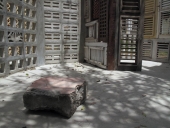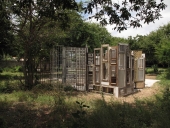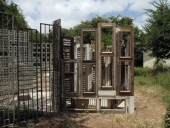OPEN-AIR ENCLOSURE
2011
permanent installation
INSTITUTO BUENA BISTA, Curaçao, Netherlands Antilles
|
second-hand wooden shutters, wooden fencing/lattice, metal fencing, concrete columns, decorative bricks
W 4,4m L 8,4m H 2,5m
|
|
On the concrete platform in the garden, a remaining trace from the past, there arose a garden pavilion, built on the wind and sun as it used to be a habit on Curaçao. The construction consists of various characteristic local building materials – second-hand wooden shutters, wooden fences/lattices, metal fences, columns, decorative bricks. The wall stretches in folds across the concrete platform creating niches in its bends. Then folding even more, with a deep bend it forms an interior space and then another one, trapping the visitors within the pavilion.
In one of the folds there is a confessionary. A part of the structure can be recognized as a shuttered land house. An altar. Or a prison….
The pavilion is a condensed experience of Curaçao, consisting of various fragments of the island. The installation refers to diversity of (personal) associations and contexts, connected with the complex historical, political and social situation of the island.
The same materials are being commonly used throughout the island, creating a distinctive architectural language that results in open airy structures fluently connecting inside spaces with outside spaces. In contradiction with the visual openness is the function of these structures to separate and close off private from the public.
OPEN-AIR ENCLOSURE
2011
permanent installation
INSTITUTO BUENA BISTA, Curaçao, Netherlands Antilles
|
second-hand wooden shutters, wooden fencing/lattice, metal fencing, concrete columns, decorative bricks
W 4,4m L 8,4m H 2,5m
|
|
On the concrete platform in the garden, a remaining trace from the past, there arose a garden pavilion, built on the wind and sun as it used to be a habit on Curaçao. The construction consists of various characteristic local building materials – second-hand wooden shutters, wooden fences/lattices, metal fences, columns, decorative bricks. The wall stretches in folds across the concrete platform creating niches in its bends. Then folding even more, with a deep bend it forms an interior space and then another one, trapping the visitors within the pavilion.
In one of the folds there is a confessionary. A part of the structure can be recognized as a shuttered land house. An altar. Or a prison….
The pavilion is a condensed experience of Curaçao, consisting of various fragments of the island. The installation refers to diversity of (personal) associations and contexts, connected with the complex historical, political and social situation of the island.
The same materials are being commonly used throughout the island, creating a distinctive architectural language that results in open airy structures fluently connecting inside spaces with outside spaces. In contradiction with the visual openness is the function of these structures to separate and close off private from the public.
|
|
